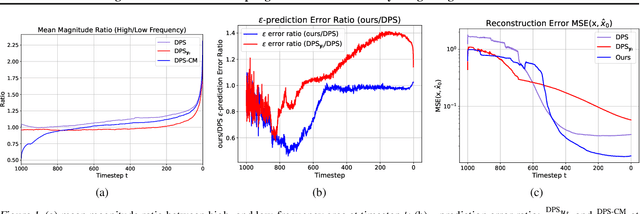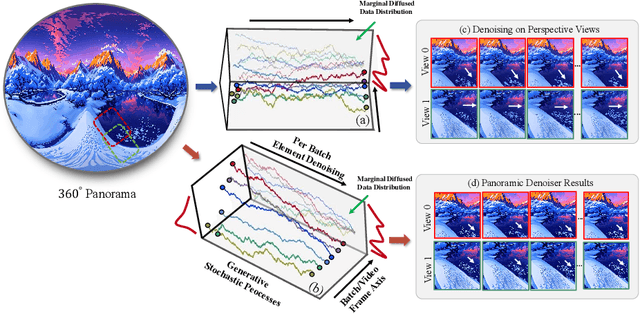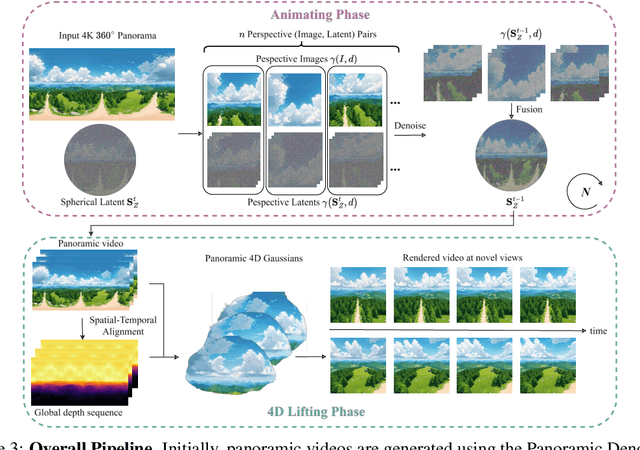Shijie Zhou
MorphoSim: An Interactive, Controllable, and Editable Language-guided 4D World Simulator
Oct 05, 2025Abstract:World models that support controllable and editable spatiotemporal environments are valuable for robotics, enabling scalable training data, repro ducible evaluation, and flexible task design. While recent text-to-video models generate realistic dynam ics, they are constrained to 2D views and offer limited interaction. We introduce MorphoSim, a language guided framework that generates 4D scenes with multi-view consistency and object-level controls. From natural language instructions, MorphoSim produces dynamic environments where objects can be directed, recolored, or removed, and scenes can be observed from arbitrary viewpoints. The framework integrates trajectory-guided generation with feature field dis tillation, allowing edits to be applied interactively without full re-generation. Experiments show that Mor phoSim maintains high scene fidelity while enabling controllability and editability. The code is available at https://github.com/eric-ai-lab/Morph4D.
SwarmAgentic: Towards Fully Automated Agentic System Generation via Swarm Intelligence
Jun 18, 2025Abstract:The rapid progress of Large Language Models has advanced agentic systems in decision-making, coordination, and task execution. Yet, existing agentic system generation frameworks lack full autonomy, missing from-scratch agent generation, self-optimizing agent functionality, and collaboration, limiting adaptability and scalability. We propose SwarmAgentic, a framework for fully automated agentic system generation that constructs agentic systems from scratch and jointly optimizes agent functionality and collaboration as interdependent components through language-driven exploration. To enable efficient search over system-level structures, SwarmAgentic maintains a population of candidate systems and evolves them via feedback-guided updates, drawing inspiration from Particle Swarm Optimization (PSO). We evaluate our method on six real-world, open-ended, and exploratory tasks involving high-level planning, system-level coordination, and creative reasoning. Given only a task description and an objective function, SwarmAgentic outperforms all baselines, achieving a +261.8% relative improvement over ADAS on the TravelPlanner benchmark, highlighting the effectiveness of full automation in structurally unconstrained tasks. This framework marks a significant step toward scalable and autonomous agentic system design, bridging swarm intelligence with fully automated system multi-agent generation. Our code is publicly released at https://yaoz720.github.io/SwarmAgentic/.
Feature4X: Bridging Any Monocular Video to 4D Agentic AI with Versatile Gaussian Feature Fields
Mar 26, 2025Abstract:Recent advancements in 2D and multimodal models have achieved remarkable success by leveraging large-scale training on extensive datasets. However, extending these achievements to enable free-form interactions and high-level semantic operations with complex 3D/4D scenes remains challenging. This difficulty stems from the limited availability of large-scale, annotated 3D/4D or multi-view datasets, which are crucial for generalizable vision and language tasks such as open-vocabulary and prompt-based segmentation, language-guided editing, and visual question answering (VQA). In this paper, we introduce Feature4X, a universal framework designed to extend any functionality from 2D vision foundation model into the 4D realm, using only monocular video input, which is widely available from user-generated content. The "X" in Feature4X represents its versatility, enabling any task through adaptable, model-conditioned 4D feature field distillation. At the core of our framework is a dynamic optimization strategy that unifies multiple model capabilities into a single representation. Additionally, to the best of our knowledge, Feature4X is the first method to distill and lift the features of video foundation models (e.g. SAM2, InternVideo2) into an explicit 4D feature field using Gaussian Splatting. Our experiments showcase novel view segment anything, geometric and appearance scene editing, and free-form VQA across all time steps, empowered by LLMs in feedback loops. These advancements broaden the scope of agentic AI applications by providing a foundation for scalable, contextually and spatiotemporally aware systems capable of immersive dynamic 4D scene interaction.
X-Dyna: Expressive Dynamic Human Image Animation
Jan 20, 2025Abstract:We introduce X-Dyna, a novel zero-shot, diffusion-based pipeline for animating a single human image using facial expressions and body movements derived from a driving video, that generates realistic, context-aware dynamics for both the subject and the surrounding environment. Building on prior approaches centered on human pose control, X-Dyna addresses key shortcomings causing the loss of dynamic details, enhancing the lifelike qualities of human video animations. At the core of our approach is the Dynamics-Adapter, a lightweight module that effectively integrates reference appearance context into the spatial attentions of the diffusion backbone while preserving the capacity of motion modules in synthesizing fluid and intricate dynamic details. Beyond body pose control, we connect a local control module with our model to capture identity-disentangled facial expressions, facilitating accurate expression transfer for enhanced realism in animated scenes. Together, these components form a unified framework capable of learning physical human motion and natural scene dynamics from a diverse blend of human and scene videos. Comprehensive qualitative and quantitative evaluations demonstrate that X-Dyna outperforms state-of-the-art methods, creating highly lifelike and expressive animations. The code is available at https://github.com/bytedance/X-Dyna.
A High-Quality Text-Rich Image Instruction Tuning Dataset via Hybrid Instruction Generation
Dec 20, 2024Abstract:Large multimodal models still struggle with text-rich images because of inadequate training data. Self-Instruct provides an annotation-free way for generating instruction data, but its quality is poor, as multimodal alignment remains a hurdle even for the largest models. In this work, we propose LLaVAR-2, to enhance multimodal alignment for text-rich images through hybrid instruction generation between human annotators and large language models. Specifically, it involves detailed image captions from human annotators, followed by the use of these annotations in tailored text prompts for GPT-4o to curate a dataset. It also implements several mechanisms to filter out low-quality data, and the resulting dataset comprises 424k high-quality pairs of instructions. Empirical results show that models fine-tuned on this dataset exhibit impressive enhancements over those trained with self-instruct data.
Enhancing Diffusion Posterior Sampling for Inverse Problems by Integrating Crafted Measurements
Nov 15, 2024



Abstract:Diffusion models have emerged as a powerful foundation model for visual generation. With an appropriate sampling process, it can effectively serve as a generative prior to solve general inverse problems. Current posterior sampling based methods take the measurement (i.e., degraded image sample) into the posterior sampling to infer the distribution of the target data (i.e., clean image sample). However, in this manner, we show that high-frequency information can be prematurely introduced during the early stages, which could induce larger posterior estimate errors during the restoration sampling. To address this issue, we first reveal that forming the log posterior gradient with the noisy measurement ( i.e., samples from a diffusion forward process) instead of the clean one can benefit the reverse process. Consequently, we propose a novel diffusion posterior sampling method DPS-CM, which incorporates a Crafted Measurement (i.e., samples generated by a reverse denoising process, compared to random sampling with noise in standard methods) to form the posterior estimate. This integration aims to mitigate the misalignment with the diffusion prior caused by cumulative posterior estimate errors. Experimental results demonstrate that our approach significantly improves the overall capacity to solve general and noisy inverse problems, such as Gaussian deblurring, super-resolution, inpainting, nonlinear deblurring, and tasks with Poisson noise, relative to existing approaches.
Large Spatial Model: End-to-end Unposed Images to Semantic 3D
Oct 24, 2024



Abstract:Reconstructing and understanding 3D structures from a limited number of images is a well-established problem in computer vision. Traditional methods usually break this task into multiple subtasks, each requiring complex transformations between different data representations. For instance, dense reconstruction through Structure-from-Motion (SfM) involves converting images into key points, optimizing camera parameters, and estimating structures. Afterward, accurate sparse reconstructions are required for further dense modeling, which is subsequently fed into task-specific neural networks. This multi-step process results in considerable processing time and increased engineering complexity. In this work, we present the Large Spatial Model (LSM), which processes unposed RGB images directly into semantic radiance fields. LSM simultaneously estimates geometry, appearance, and semantics in a single feed-forward operation, and it can generate versatile label maps by interacting with language at novel viewpoints. Leveraging a Transformer-based architecture, LSM integrates global geometry through pixel-aligned point maps. To enhance spatial attribute regression, we incorporate local context aggregation with multi-scale fusion, improving the accuracy of fine local details. To tackle the scarcity of labeled 3D semantic data and enable natural language-driven scene manipulation, we incorporate a pre-trained 2D language-based segmentation model into a 3D-consistent semantic feature field. An efficient decoder then parameterizes a set of semantic anisotropic Gaussians, facilitating supervised end-to-end learning. Extensive experiments across various tasks show that LSM unifies multiple 3D vision tasks directly from unposed images, achieving real-time semantic 3D reconstruction for the first time.
4K4DGen: Panoramic 4D Generation at 4K Resolution
Jun 19, 2024



Abstract:The blooming of virtual reality and augmented reality (VR/AR) technologies has driven an increasing demand for the creation of high-quality, immersive, and dynamic environments. However, existing generative techniques either focus solely on dynamic objects or perform outpainting from a single perspective image, failing to meet the needs of VR/AR applications. In this work, we tackle the challenging task of elevating a single panorama to an immersive 4D experience. For the first time, we demonstrate the capability to generate omnidirectional dynamic scenes with 360-degree views at 4K resolution, thereby providing an immersive user experience. Our method introduces a pipeline that facilitates natural scene animations and optimizes a set of 4D Gaussians using efficient splatting techniques for real-time exploration. To overcome the lack of scene-scale annotated 4D data and models, especially in panoramic formats, we propose a novel Panoramic Denoiser that adapts generic 2D diffusion priors to animate consistently in 360-degree images, transforming them into panoramic videos with dynamic scenes at targeted regions. Subsequently, we elevate the panoramic video into a 4D immersive environment while preserving spatial and temporal consistency. By transferring prior knowledge from 2D models in the perspective domain to the panoramic domain and the 4D lifting with spatial appearance and geometry regularization, we achieve high-quality Panorama-to-4D generation at a resolution of (4096 $\times$ 2048) for the first time. See the project website at https://4k4dgen.github.io.
Towards a Novel Perspective on Adversarial Examples Driven by Frequency
Apr 16, 2024



Abstract:Enhancing our understanding of adversarial examples is crucial for the secure application of machine learning models in real-world scenarios. A prevalent method for analyzing adversarial examples is through a frequency-based approach. However, existing research indicates that attacks designed to exploit low-frequency or high-frequency information can enhance attack performance, leading to an unclear relationship between adversarial perturbations and different frequency components. In this paper, we seek to demystify this relationship by exploring the characteristics of adversarial perturbations within the frequency domain. We employ wavelet packet decomposition for detailed frequency analysis of adversarial examples and conduct statistical examinations across various frequency bands. Intriguingly, our findings indicate that significant adversarial perturbations are present within the high-frequency components of low-frequency bands. Drawing on this insight, we propose a black-box adversarial attack algorithm based on combining different frequency bands. Experiments conducted on multiple datasets and models demonstrate that combining low-frequency bands and high-frequency components of low-frequency bands can significantly enhance attack efficiency. The average attack success rate reaches 99\%, surpassing attacks that utilize a single frequency segment. Additionally, we introduce the normalized disturbance visibility index as a solution to the limitations of $L_2$ norm in assessing continuous and discrete perturbations.
DreamScene360: Unconstrained Text-to-3D Scene Generation with Panoramic Gaussian Splatting
Apr 10, 2024Abstract:The increasing demand for virtual reality applications has highlighted the significance of crafting immersive 3D assets. We present a text-to-3D 360$^{\circ}$ scene generation pipeline that facilitates the creation of comprehensive 360$^{\circ}$ scenes for in-the-wild environments in a matter of minutes. Our approach utilizes the generative power of a 2D diffusion model and prompt self-refinement to create a high-quality and globally coherent panoramic image. This image acts as a preliminary "flat" (2D) scene representation. Subsequently, it is lifted into 3D Gaussians, employing splatting techniques to enable real-time exploration. To produce consistent 3D geometry, our pipeline constructs a spatially coherent structure by aligning the 2D monocular depth into a globally optimized point cloud. This point cloud serves as the initial state for the centroids of 3D Gaussians. In order to address invisible issues inherent in single-view inputs, we impose semantic and geometric constraints on both synthesized and input camera views as regularizations. These guide the optimization of Gaussians, aiding in the reconstruction of unseen regions. In summary, our method offers a globally consistent 3D scene within a 360$^{\circ}$ perspective, providing an enhanced immersive experience over existing techniques. Project website at: http://dreamscene360.github.io/
 Add to Chrome
Add to Chrome Add to Firefox
Add to Firefox Add to Edge
Add to Edge